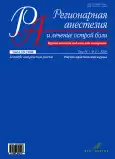Двойное слепое рандомизированное исследование миотоксичности лидокаина, бупивакаина, левобупивакаина и ропивакаина у крыс
- Авторы: Лахин Р.Е.1, Гемуа И.А.1, Аверьянов Д.А.1
-
Учреждения:
- ФГБВОУ ВО «Военно-медицинская академия им. С.М. Кирова» Министерства образования Российской Федерации
- Выпуск: Том 14, № 2 (2020)
- Страницы: 93-108
- Раздел: Оригинальные статьи
- URL: https://journals.rcsi.science/1993-6508/article/view/56574
- DOI: https://doi.org/10.17816/1993-6508-2020-14-2-93-108
- ID: 56574
Цитировать
Аннотация
Актуальность. Миотоксичность местных анестетиков (МА) в клинической практике была выявлена при различных видах регионарной анестезии. Степень функционального восстановления повреждëнных мышц и продолжительность времени до восстановления в разных исследованиях существенно различаются. Несмотря на общепринятое мнение о противовоспалительном действии МА, ряд экспериментальных исследований показал, что в месте их инъекции в мышечную ткань развивалась воспалительная реакция.
Материал и методы. Двойное слепое рандомизированное исследование на 800 крысах, где в контрольной группе вводился 0,9% хлорид натрия. Исследуемые концентрации лидокаина 0,5, 1,0, 1,5, 2%; бупивакаина, ропивакаина — 0,25, 0,5, 0,75, 1,0%; ропивакаина – 0,25, 0,5, 0,75%. Под ультразвуковым контролем вводили 0,2 мл препарата внутрь двуглавой мышцы. Забор препаратов: 1-й этап через час после введения, 2-й этап через 2 сут., 3-й – через 7 сут., 4-й – через 14 сут., 5-й – через 21 сут. Исследовали признаки воспаления и повреждения мышечной ткани.
Результаты. Инъекция физиологического раствора лабораторным животным контрольной группы вызывала расширение межклеточных пространств и соединительнотканных перегородок. Признаков некроза клеток или апоптоза обнаружено не было. Введение МА уже через час вызывало воспалительную инфильтрацию и повреждение мышечной ткани. Полученные данные попарных сравнений показали, что на этапах час и 2 сут. во всех исследуемых группах выраженность повреждения и воспаления была больше, чем в группе с введением 0,9% раствора хлорида натрия. Затем происходило снижение признаков повреждения и воспаления. На этапе 21 сут. статистических различий при сравнении с 1-й группой уже не было ни в одной исследуемой группе. Зависимость проявлений повреждения или воспалительных изменений в мышечной ткани от концентрации МА была определена с помощью построения порядковой регрессионной модели. Показатели регрессионной модели были значимы. Они позволяли описать 87% для повреждения и 95% для воспалительных изменений.
Заключение. Миотоксичность МА проявлялась в виде повреждающего действия и в виде развития воспалительной инфильтрации. Миотоксичностью обладали все концентрации всех исследуемых МА. Чем выше была концентрация анестетика, тем более выраженно было повреждающее действие и развитие признаков воспаления. Максимальное развитие повреждающего действия было на этапах 1 ч и 2-х сут. исследования, в дальнейшем происходило уменьшение признаков миотоксичности и к 21-м сут. признаки повреждения и воспаления практически полностью исчезали. Сравнительный анализ не выявил статистических различий, позволяющих однозначно сформировать рейтинг от наиболее к наименее миотоксичному препарату.
Ключевые слова
Полный текст
Открыть статью на сайте журналаОб авторах
Роман Евгеньевич Лахин
ФГБВОУ ВО «Военно-медицинская академия им. С.М. Кирова» Министерства образования Российской Федерации
Автор, ответственный за переписку.
Email: doctor-lahin@yandex.ru
ORCID iD: 0000-0001-6431-439X
д. мед. н., профессор кафедры военной анестезиологии и реаниматологии
Россия, 194044, Санкт-ПетербургИ. А. Гемуа
ФГБВОУ ВО «Военно-медицинская академия им. С.М. Кирова» Министерства образования Российской Федерации
Email: doctor-lahin@yandex.ru
ORCID iD: 0000-0002-8643-252X
Россия, 194044, Санкт-Петербург
Д. А. Аверьянов
ФГБВОУ ВО «Военно-медицинская академия им. С.М. Кирова» Министерства образования Российской Федерации
Email: doctor-lahin@yandex.ru
ORCID iD: 0000-0003-4353-4953
Россия, 194044, Санкт-Петербург
Список литературы
- Kim C.H., Kim U.S. Response to: Bilateral lateral rectus myotoxicity after retrobulbar anesthesia. Indian J. Ophthalmol. 2016;64(6):473-4. doi: 10.4103/0301-4738.187685.
- Kalantzis G., Papaconstantinou D., Karagiannis D., Koutsandrea C., Stavropoulou D., Georgalas I. Post-cataract surgery diplopia: aetiology, management and prevention. Clin. Exp. Optom. 2014;97(5):407-10. doi: 10.1111/cxo.12197
- Neal J.M., Salinas F.V., Choi D.S. Local Anesthetic-Induced Myotoxicity After Continuous Adductor Canal Block. Reg. Anesth. Pain. Med. 2016;41(6):723-7. doi: 10.1097/AAP.0000000000000466.
- Rhee S.M., Chung N.Y., Jeong H.J., Oh J.H. Subacromial Local Anesthetics Do Not Interfere With Rotator Cuff Healing After Arthroscopic Repair. Am. J. Sports Med. 2018;46(5):1097-105. doi: 10.1177/0363546517753827.
- Scott N.A., Guo B., Barton P.M., Gerwin R.D. Trigger point injections for chronic non-malignant musculoskeletal pain: a systematic review. Pain Med. 2009;10(1):54-69. doi: 10.1111/j.1526-4637.2008.00526.x.
- Hussain N., McCartney C.J.L., Neal J.M., Chippor J., Banfield L., Abdallah F.W.. Local anaesthetic-induced myotoxicity in regional anaesthesia: a systematic review and empirical analysis. Br. J. Anaesth. 2018;121(4):822-841. doi: 10.1016/j.bja.2018.05.076.
- Neal J.M., Barrington M.J., Brull R. et al. The Second ASRA Practice Advisory on Neurologic Complications Associated With Regional Anesthesia and Pain Medicine: Executive Summary 2015. Reg. Anesth. Pain Med. 2015;40(5):401-30. doi: 10.1097/AAP.0000000000000286.
- Zink W., Sinner B., Zausig Y., Graf B.M. Myotoxicity of local anaesthetics: experimental myth or clinical truth? Anaesthesist. 2007; 56(2):118-127. doi: 10.1007/s00101-006-1121-5.
- Zink W., Graf B.M. Local anesthetic myotoxicity. Reg. Anesth. Pain. Med. 2004;29(4):333-40. doi: 10.1016/j.rapm.2004.02.008.
- McAlvin J.B., Reznor G., Shankarappa S.A., Stefanescu C.F., Kohane D.S. Local toxicity from local anesthetic polymeric microparticles. Anesth. Analg. 2013;116(4):794-803. doi: 10.1213/ANE.0b013e31828174a7.
- Oz Gergin O., Bayram A., Gergin I.S. et al. Comparison of myotoxic effects of levobupivacaine, bupivacaine and ropivacaine: apoptotic activity and acute effect on pro-inflammatory cytokines. Biotech. Histochem. 2019;94(4):252-260. doi: 10.1080/10520295.2018.1548711.
- Zhang C., Phamonvaechavan P., Rajan A., Poon D.Y., Topcu-Yilmaz P., Guyton D.L. Concentration-dependent bupivacaine myotoxicity in rabbit extraocular muscle. J. AAPOS. 2010;14(4):323-327. doi: 10.1016/j.jaapos.2010.05.009.
- Fayed N.A., el-Zoghby S.A. Myotoxic effects of different doses of lidocaine with or without epinephrine in rats. Egypt Dent. J. 1987;33(3):297-307.
- Komorowski T.E., Shepard B., Okland S., Carlson B.M. An electron microscopic study of local anesthetic-induced skeletal muscle fiber degeneration and regeneration in the monkey. J. Orthop. Res. 1990;8(4):495-503. doi: 10.1002/jor.1100080405.
- Benoit P.W., Yagiela A., Fort N.F. Pharmacologic correlation between local anesthetic-induced myotoxicity and disturbances of intracellular calcium distribution. Toxicol. Appl. Pharmacol. 1980;52(2):187-98. doi: 10.1016/0041-008x(80) 90105-2.
- Kapoukranidou D., Amaniti E., Kalpidis J. et al. Effect of ropivacaine infiltration on muscle regeneration: a morphometric analysis. Hippokratia. 2013;17(4):351-4.
- Yildiz K., Efesoy S.N., Ozdamar S. et al. Myotoxic effects of levobupivacaine, bupivacaine and ropivacaine in a rat model. Clin. Invest. Med. 2011;34(5):E273. Published 2011 Oct 1. doi: 10.25011/cim.v34i5.15670.
- Zink W., Seif C., Bohl J.R. et al. The acute myotoxic effects of bupivacaine and ropivacaine after continuous peripheral nerve blockades. Anesth. Analg. 2003;97(4):1173-9. doi: 10.1213/01.ane.0000080610.14265.c8.
- Park C.Y., Park S.E., Oh S.Y. Acute effect of bupivacaine and ricin mAb 35 on extraocular muscle in the rabbit. Curr .Eye Res. 2004;29(4-5):293-301. doi: 10.1080/027136804905161.
Дополнительные файлы









